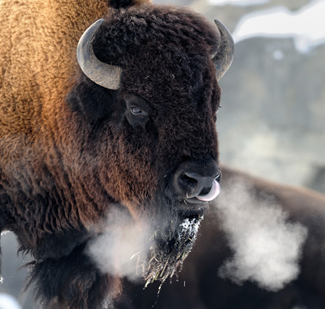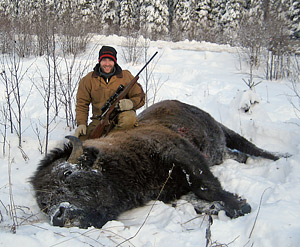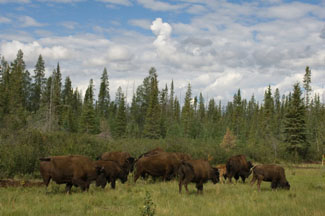Free ranging and wild wood bison are one of North America’s most unique and impressive trophies and the largest land mammal on the continent. They are heavier than Alaska’s famous Kodiak Bear and averaging 500 pounds heavier than Africa’s infamous Cape Buffalo, one of the dangerous five game species. Adult males are approximately six feet tall at the shoulder, 10 feet long and 15 percent heavier than the plains bison. There are very few places that allow you to hunt bison in a truly wild environment; one location is just outside of the Wood Buffalo National Park, Alberta, Canada.  When wood bison populations were driven to the point of extinction in the late 1800s, declining population had dropped from an estimated 40 million in 1830 to less than 1000 by 1900. Today, Wood Buffalo National Park is still a vast natural wilderness of remote boreal forest, parkland and wetland along the Peace, Athabasca, and Slave Rivers where the bison thrive. The parkland is heavily wooded and difficult to accurately survey. The most current data places the population well over 2,000 animals, possibly as high as 10,000.
When wood bison populations were driven to the point of extinction in the late 1800s, declining population had dropped from an estimated 40 million in 1830 to less than 1000 by 1900. Today, Wood Buffalo National Park is still a vast natural wilderness of remote boreal forest, parkland and wetland along the Peace, Athabasca, and Slave Rivers where the bison thrive. The parkland is heavily wooded and difficult to accurately survey. The most current data places the population well over 2,000 animals, possibly as high as 10,000.
Wood Buffalo National Park was created in 1922 to encompass much of this prime habitat. The park is approximately 12 million acres. Located in Northern Alberta, the park extends into Canada’s North West Territories to just south of Great Slave Lake. Plains bison were shipped to the park from Wainwright, Alberta, between 1925 and 1928. The imported bison promptly moved south of the Peace River into the Peace-Athabasca Delta area. In 1926, the park boundaries were expanded to include this new bison range. Today, Wood Buffalo National Park protects one of the largest free-roaming, self-regulating bison herds in the world.
The bison in Wood Buffalo National Park were designated as a separate subspecies, due to characteristics such as larger size and darker coloration. The heavier woolen part of the wood buffalo’s cape extends much farther back than on an American Plains bison, with a pronounced hump ahead of the front legs. They have curving horns that point upward and hair on their chin that resembles a beard. The bone structure of this giant, forward hump has evolved in the northern wood bison to support massive forward muscle structure that helps them sweep through deeper northern snows with their head to access grasses and sedges in winter.
Under provincial legislation, wood bison east of Highway 35 and west of Wood Buffalo National Park can be hunted without a license. Hunters have the opportunity to hunt bison as they exit the park and enter legal hunting zones. Outside the park, buffalo feed in scattered pockets of grassland found along beaver ponds, rivers, and bog lakes.
The reason that these bison can be hunted outside of the park is to prevent the spread of brucellosis and bovine tuberculosis.
 The Alberta government has a disease-management program to protect the province’s agriculture industry and disease-free wood bison in northwestern Alberta. All free-ranging wood bison detected on private agricultural lands near Fort Vermilion, La Crete and within six miles of Highway 35 will be hunted or removed. Bison populations west of Wood Buffalo National Park will continue to be surveyed to confirm numbers, location and whether they carry any disease, and hunters are asked to submit samples for testing. This effort will continue until a long-term solution is applied to the bison in and around Wood Buffalo National Park.
The Alberta government has a disease-management program to protect the province’s agriculture industry and disease-free wood bison in northwestern Alberta. All free-ranging wood bison detected on private agricultural lands near Fort Vermilion, La Crete and within six miles of Highway 35 will be hunted or removed. Bison populations west of Wood Buffalo National Park will continue to be surveyed to confirm numbers, location and whether they carry any disease, and hunters are asked to submit samples for testing. This effort will continue until a long-term solution is applied to the bison in and around Wood Buffalo National Park.
The risk of disease transmission to humans remains very low and those who continue to harvest bison are encouraged to contact the local Fish and Wildlife office for information on the risks associated with brucellosis and tuberculosis.
As the bison are wild and can freely enter and exit the park, it can be difficult to predict when they can be hunted. The late winter and early spring hunt, February through March, with the snow just departing and the bugs yet to arrive, is the best time to hunt.
They begin to lose their winter coat as temperatures warm in the early spring. By mid-summer, it is completely shed and has been replaced with new hair. Bulls may weigh up to 3,000 pounds. Fortunately, these bison are not a pure wood bison, therefore allowing American hunters to export the cape and horns to the United States without the need of a CITES permit.
 Hunting wood bison is one of the most extreme hunts in the world, with weather temperature and conditions like that of the Arctic during hunts for polar bear or musk-ox.
Hunting wood bison is one of the most extreme hunts in the world, with weather temperature and conditions like that of the Arctic during hunts for polar bear or musk-ox.
Because of deep snow averaging 2-3 feet, hunters must use snowmobiles and snowshoes to move around, traveling up to 50 miles or more in a day tracking down the bison. The hunt, if booked with an outfitter, will range up to $10,000 for six days, but all equipment, including snowmobiles, accommodations, meals and game handling and preparations are taken care of; taxes and transportation to Alberta are extra.
Calibers for hunting bison should be a minimum of 30-06, up to a truly American bison cartridge, the 475 Turnbull made for Winchester models 1886 and 71, and the African big game rifle the Ruger model No.1.
Some important information in bringing a non-restricted firearm into Canada is as follows:
1. You must be at least 18 years old
2. You must declare your firearms at your first point of entry; in most cases, you will have to declare your firearms in writing, using a non-resident firearm deceleration form, a customs officer must confirm your declaration, the confirmed declaration will serve as a temporary license and registration certificate for up to 60 days.
3. The cost will be $50 CDN and can be renewed any number of times within a 12 month period at no extra cost.
You can obtain forms and additional information on the legal requirements under the Canadian Firearms Act by calling (800) 731-4000.